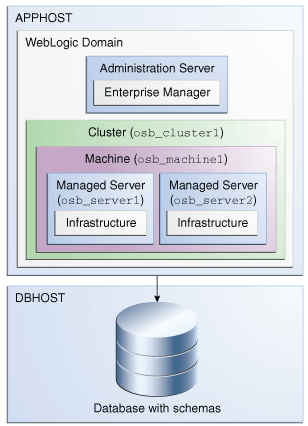1 About the Oracle Service Bus Installation
Using the Standard Installation Topology As a Starting Point
The standard installation topology is a flexible topology that you can use as a starting point in production environments.
The information in this guide helps you to create a standard installation topology for Oracle Service Bus. If required, you can later extend the standard installation topology to create a secure and highly available production environment, see Next Steps After Configuring the Domain.
The standard installation topology represents a sample topology for this product. It is not the only topology that this product supports. See About the Standard Installation Topology in Planning an Installation of Oracle Fusion Middleware.
About the Oracle Service Bus Standard Installation Topology
(Required) <Enter a short description here.>
The following figure shows the standard installation topology for Oracle Service Bus.
Figure 1-1 Standard Installation Topology for Oracle Service Bus

Description of "Figure 1-1 Standard Installation Topology for Oracle Service Bus "
About Elements in the Standard Installation Topology Illustration
The standard installation topology typically includes common elements.
Table 1-1 describes all elements of the topology illustration:
Table 1-1 Description of Elements in Standard Installation Topologies
| Element | Description and Links to Related Documentation |
|---|---|
| APPHOST | A standard term used in Oracle documentation to refer to the machine that hosts the application tier. |
| DBHOST | A standard term used in Oracle documentation to refer to the machine that hosts the database. |
| WebLogic Domain | A logically related group of Java components (in this case, the Administration Server, Managed Servers, and other related software components) and non-Java components.
See What Is an Oracle WebLogic Server Domain? in Understanding Oracle Fusion Middleware. |
| Administration Server | Central control entity of a WebLogic domain. It maintains
configuration objects for that domain and distributes configuration
changes to Managed Servers.
See What Is the Administration Server? in Understanding Oracle Fusion Middleware. |
| Enterprise Manager | The Oracle Enterprise Manager Fusion Middleware Control
is a primary tool used to manage a domain.
See Oracle Enterprise Manager Fusion Middleware Control in Understanding Oracle Fusion Middleware. |
| Cluster | A collection of multiple WebLogic Server instances
running simultaneously and working together.
See Overview of Managed Servers and Managed Server Clusters in Understanding Oracle Fusion Middleware. |
| Machine | A logical representation of the computer that hosts one or more WebLogic Server instances (servers). Machines are also the logical glue between the Managed Servers and the Node Manager. In order to start or stop the Managed Servers using the Node Manager, associate the Managed Servers with a machine. |
| Managed Server | A host for your applications, application
components, web services, and their associated resources.
See Overview of Managed Servers and Managed Server Clusters in Understanding Oracle Fusion Middleware. |
| Infrastructure | A collection of services that include the
following:
|
About Secondary Topologies
Secondary topologies include configurations with components that require additional installation or configuration steps on top of the standard topology.
The main sections of this guide describe how to install and configure a standard installation topology. The secondary topologies contain several products that are not identified or included in the standard installation topologies.
For guidelines to install and configure secondary topologies, see Oracle Service Bus and Oracle Enterprise Scheduler Topology.
Using This Document to Extend an Existing Domain
The procedures in this guide describe how to create a new domain. The assumption is that no other Oracle Fusion Middleware products are installed on your system.
If you have installed and configured other Oracle Fusion Middleware products on your system (for example, Fusion Middleware Infrastructure, with a domain that is up and running) and wish to extend the same domain to include Oracle Service Bus, see Installing Multiple Products in the Same Domain.